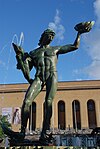You can help expand this article with text translated from the corresponding article in Swedish. (May 2015)Click [show] for important translation instructions.
|
 Vinga Lighthouse | |
 | |
| Location | Vinga island Gothenburg Archipelago Sweden |
|---|---|
| Coordinates | 57°37′55″N11°36′05″E / 57.63206°N 11.60131°E |
| Tower | |
| Constructed | 1841 (first) 1854 (second) |
| Foundation | porphyry |
| Construction | porphyry tower |
| Automated | 1974 |
| Height | 29 m (95 ft) |
| Shape | square tower with balcony and lantern |
| Markings | unpainted tower, grey metallic lantern dome |
| Power source | kerosene, electricity |
| Operator | Swedish Maritime Administration (Sjöfartsverket) [1] |
| Heritage | governmental listed building |
| Light | |
| First lit | 1890 (current) |
| Focal height | 46 m (151 ft) |
| Lens | 1st order Fresnel lens |
| Range | 25 nautical miles (46 km; 29 mi) |
| Characteristic | Fl (2) W 30s. |
| Sweden no. | SV-7547 |
Vinga Lighthouse (Swedish : Vinga fyr), is a Swedish lighthouse on Vinga island. The present-day lighthouse was built in 1890, although Vinga has been a significant island for mariners long before that. This lighthouse is the third built on the island. It is one of Sweden's most noted lighthouses and a special symbol for the city of Gothenburg.
